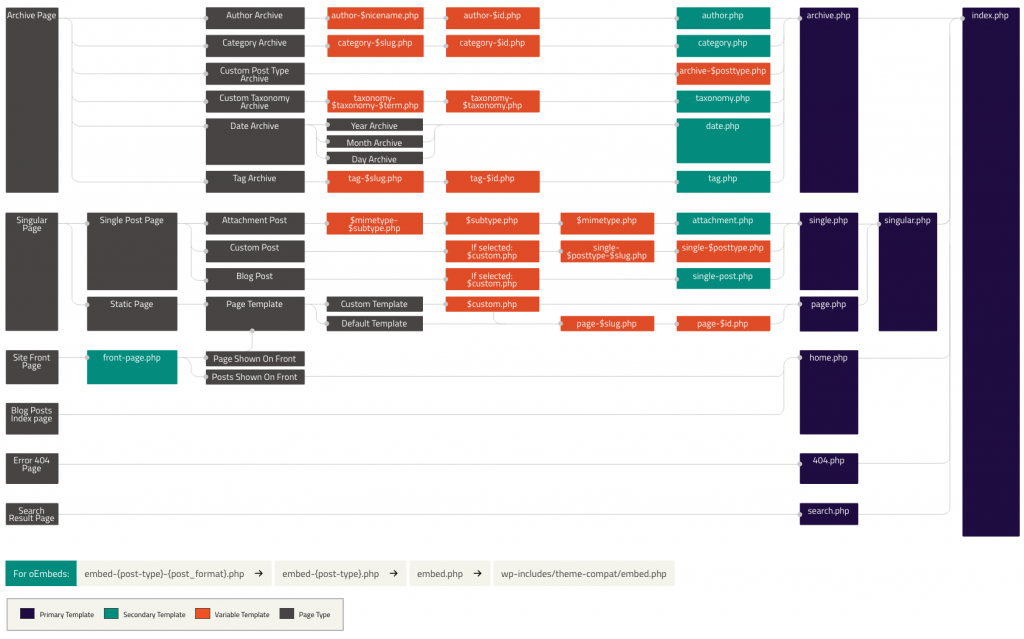如上所述,??模板文件??是模塊化的,可重用的文件,用于在WordPress網站上生成網頁。某些模板文件(例如頁眉和頁腳模板)用于您網站的所有頁面,而其他模板文件僅在特定條件下使用。
本文介紹了WordPress如何確定在各個頁面上使用哪些模板文件。如果要自定義現有的WordPress主題,它將幫助您確定需要編輯哪個模板文件。
- 原文來源:wordpress文檔
提示:
您還可以使用條件標簽來控制在特定頁面上加載的模板。
模板文件層次結構
概述
WordPress使用查詢字符串來決定應該使用哪個模板或模板集來顯示頁面。查詢字符串是包含在網站每個部分的鏈接中的信息。它出現在初始問號之后,可能包含許多由&符號分隔的參數。
簡而言之,WordPress向下搜索模板層次結構,直到找到匹配的模板文件。要確定要使用的模板文件,WordPress:
- 將每個查詢字符串與查詢類型匹配,以決定請求哪個頁面(例如,搜索頁面,類別頁面等);
- 按模板層次結構確定的順序選擇模板;
- 在當前主題的目錄中查找具有特定名稱的模板文件,并使用層次結構指定的第一個匹配模板文件。
除基本index.php模板文件外,您可以選擇是否要實現特定模板文件。
如果WordPress找不到具有匹配名稱的模板文件,它將跳轉到層次結構中的下一個文件。如果WordPress找不到任何匹配的模板文件,index.php將使用主題的文件。
示例
如果您的博客位于,http://example.com/blog/并且訪問者點擊指向類別頁面的鏈接,例如??http://example.com/blog/category/your-cat/,WordPress會在當前主題的目錄中查找與該類別的ID匹配的模板文件,以生成正確的頁面。更具體地說,WordPress遵循以下過程:
- 在當前主題的目錄中查找與類別的slug匹配的模板文件。如果類別slug是“unicorns”,則WordPress會查找名為的模板文件
category-unicorns.php。 - 如果
category-unicorns.php缺少并且類別的ID為4,則WordPress將查找名為的模板文件category-4.php。 - 如果
category-4.php缺少,WordPress將尋找通用類別模板文件,category.php。 - 如果
category.php不存在,WordPress將尋找通用存檔模板,archive.php。 - 如果
archive.php還缺少,WordPress將回退到主題模板文件,index.php。
視覺概述
下圖顯示了調用哪些模板文件以基于WordPress模板層次結構生成WordPress頁面。

模板層次結構詳細信息
雖然模板層次結構更易于理解為圖表,但以下部分描述了WordPress為多種查詢類型調用模板文件的順序。
主頁顯示
默認情況下,WordPress會設置您網站的主頁以顯示您最新的博文。此頁面稱為博客帖子索引。您還可以將博客帖子設置為顯示在單獨的靜態頁面上。模板文件home.php用于呈現博客帖子索引,無論是用作首頁還是用于單獨的靜態頁面。如果??home.php?不存在,WordPress將使用??index.php。
home.phpindex.php
注意:
如果front-page.php?存在,它將覆蓋??home.php?模板。
首頁顯示
該front-page.php模板文件是用來使您的網站的頭版,頭版是否顯示該博客文章的索引(上述)或靜態頁面。首頁模板優先于博客文章index(home.php)模板。如果該front-page.php文件不存在,WordPress將使用home.php或page.php文件,具體取決于設置→閱讀中的設置。如果這兩個文件都不存在,它將使用該index.php文件。
front-page.php?- 用于設置→閱讀的首頁顯示部分中設置的“?您的最新帖子?”或“?靜態頁面?”?。home.php?- 如果WordPress無法找到,??front-page.php并且在首頁顯示部分設置了“?您的最新帖子?”?,則會查找。此外,當在首頁顯示部分設置帖子頁面時,WordPress將查找此文件。home.phppage.php?- 在首頁顯示部分設置“?首頁?”時。index.php?-當“?你最新的帖子?”被設置在頭版顯示部分,但??home.php不存在或??在頭版設置,但page.php不存在。
正如您所看到的,WordPress采用的路徑有很多規則。使用上面的圖表是確定WordPress將顯示的最佳方式。
單帖
單個帖子模板文件用于呈現單個帖子。WordPress使用以下路徑:
single-{post-type}-{slug}.php?- (從4.4開始)首先,WordPress會查找特定帖子的模板。例如,如果帖子類型是product和post slug是dmc-12,WordPress會尋找single-product-dmc-12.php。single-{post-type}.php- 如果帖子類型是product,WordPress會尋找single-product.php。single.php- 然后WordPress回歸single.php。singular.php- 然后它又回落了singular.php。index.php- 最后,如上所述,WordPress最終會回歸index.php。
單頁
用于呈現靜態頁面的模板文件(pagepost-type)。請注意,與其他post-types不同,pageWordPress特殊并使用以下路徑:
custom template file?-?分配給頁面的頁面模板。見get_page_templates()。page-{slug}.php?- 如果頁面slug是recent-news,WordPress將使用page-recent-news.php。page-{id}.php?- 如果頁面ID為6,WordPress將使用page-6.php。page.phpsingular.phpindex.php
類別
渲染類別歸檔索引頁面在WordPress中使用以下路徑:
category-{slug}.php?- 如果類別的slug是news,WordPress將尋找category-news.php。category-{id}.php?- 如果類別的ID是6,WordPress將尋找category-6.php。category.phparchive.phpindex.php
標簽
要顯示標記歸檔索引頁,WordPress使用以下路徑:
tag-{slug}.php?- 如果標簽的slug是sometag,WordPress將尋找tag-sometag.php。tag-{id}.php?- 如果標簽的ID是6,WordPress將尋找tag-6.php。tag.phparchive.phpindex.php
自定義分類法
自定義分類法使用稍微不同的模板文件路徑:
taxonomy-{taxonomy}-{term}.php?- 如果分類法是sometax,而分類學的術語是someterm,WordPress將尋找taxonomy-sometax-someterm.php.在帖子格式的情況下,分類法是'post_format',術語是'post-format- {format}。即taxonomy-post_format-post-format-link.php?鏈接格式。taxonomy-{taxonomy}.php?- 如果分類法是sometax,WordPress會尋找taxonomy-sometax.php。taxonomy.phparchive.phpindex.php
自定義帖子類型
自定義帖子類型使用以下路徑來呈現相應的存檔索引頁面。
archive-{post_type}.php?- 如果帖子類型是product,WordPress將尋找archive-product.php。archive.phpindex.php
(要渲染單個帖子類型模板,請參閱上面的單個帖子顯示部分。)
作者顯示
基于以上示例,呈現作者歸檔索引頁面是相當明確的:
author-{nicename}.php?- 如果作者的名字很好matt,WordPress會尋找author-matt.php。author-{id}.php?- 如果作者的ID是6,WordPress將尋找author-6.php。author.phparchive.phpindex.php
日期
基于日期的歸檔索引頁面將按預期呈現:
date.phparchive.phpindex.php
搜索結果
搜索結果遵循與其他模板類型相同的模式:
search.phpindex.php
404(未找到)
同樣,按以下順序調用404模板文件:
404.phpindex.php
附件
呈現附件頁面(attachmentpost-type)使用以下路徑:
{MIME-type}.php-可以是任何的MIME類型(例如:??image.php,video.php,pdf.php)。對于text/plain,使用以下路徑(按順序):text-plain.phpplain.phptext.phpattachment.phpsingle-attachment-{slug}.php?- 例如,如果附件slug是holiday,WordPress會尋找single-attachment-holiday.php。single-attachment.phpsingle.phpsingular.phpindex.php
內嵌
嵌入模板文件用于呈現正在嵌入的帖子。從4.5開始,WordPress使用以下路徑:
embed-{post-type}-{post_format}.php?- 首先,WordPress尋找特定帖子的模板。例如,如果它的帖子類型是,post并且它具有音頻格式,WordPress會尋找embed-post-audio.php。embed-{post-type}.php- 如果帖子類型是product,WordPress會尋找embed-product.php。embed.php- 然后WordPress回歸嵌入.php。- 最后,WordPress最終回歸到自己的
wp-includes/theme-compat/embed.php模板。
非ASCII字符處理
從WordPress 4.7開始,模板名稱的任何動態部分(其名稱中包含非ASCII字符)實際上都支持未編碼形式和編碼形式。您可以選擇使用哪個。
這是名為“Hello World?”?的頁面的頁面模板層次結構,其ID為6:
page-hello-world-.phppage-hello-world-%f0%9f%98%80.phppage-6.phppage.phpsingular.php
相同的行為適用于post slugs,term names和author nicenames。
過濾層次結構
WordPress模板系統允許您過濾層次結構。這意味著您可以在層次結構的特定點插入和更改內容。過濾器(位于get_query_template()函數中)使用此過濾器名稱:"{$type}_template"其中$type是模板類型。
以下是模板層次結構中所有可用過濾器的列表:
embed_template404_templatesearch_templatefrontpage_templatehome_templatetaxonomy_templateattachment_templatesingle_templatepage_templatesingular_templatecategory_templatetag_templateauthor_templatedate_templatearchive_templateindex_template
示例
例如,讓我們采用默認的作者層次結構:
author-{nicename}.phpauthor-{id}.phpauthor.php
要添加author-{role}.php之前author.php,我們可以使用'author_template'模板類型操縱實際層次結構。這允許對/ author / username的請求,其中username具有編輯器的角色,使用author-editor.php顯示(如果存在于當前主題目錄中)。
function author_role_template( $templates = '' ) {
$author = get_queried_object();
$role = $author->roles[0];
if ( ! is_array( $templates ) && ! empty( $templates ) ) {
$templates = locate_template( array( "author-$role.php", $templates ), false );
} elseif ( empty( $templates ) ) {
$templates = locate_template( "author-$role.php", false );
} else {
$new_template = locate_template( array( "author-$role.php" ) );
if ( ! empty( $new_template ) ) {
array_unshift( $templates, $new_template );
}
}
return $templates;
}
add_filter( 'author_template', 'author_role_template' );

